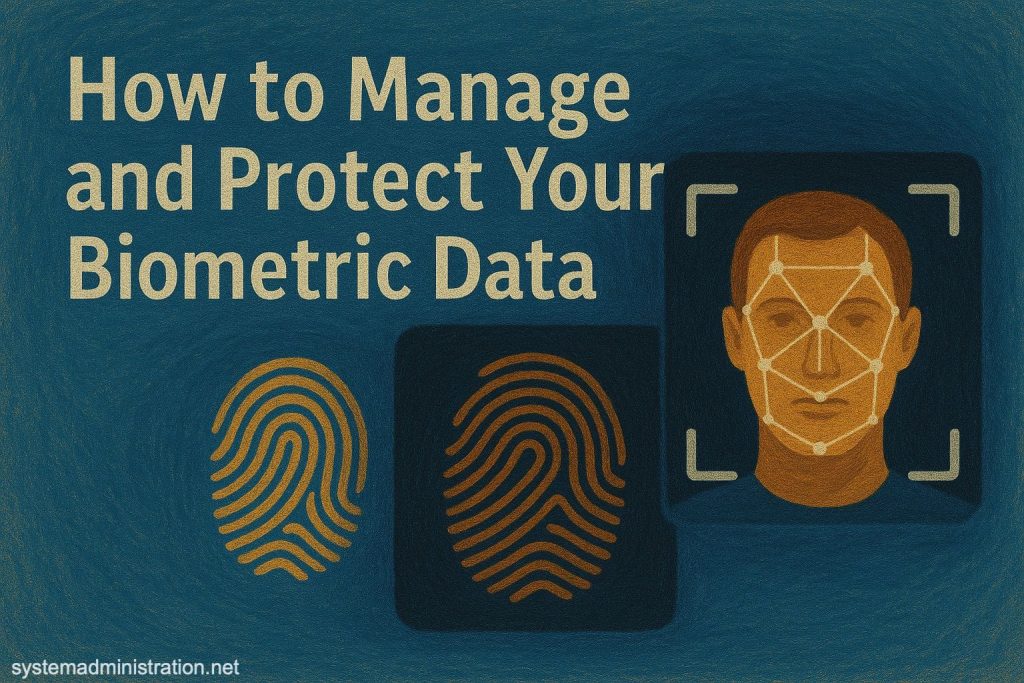Biometric data refers to the unique physical or behavioral characteristics used to verify a person’s identity. As biometric technologies become more integrated into our daily lives, it’s essential to understand how to manage and protect this sensitive information.
Table of Contents
Why Protecting Biometric Data Matters
Unlike passwords, biometric data is unique and permanent. Changing a password is straightforward, but once your biometric identifiers, such as fingerprints or iris scans, are compromised, they cannot be changed. This makes biometric data particularly vulnerable if stolen. Cybercriminals can use stolen biometric data to impersonate someone, bypass security systems, and gain unauthorized access to sensitive accounts and personal information.
Moreover, many people are unaware of how their biometric data is collected and used. Often, we see in movies and TV shows how facial recognition is used for surveillance, yet we rarely understand the full extent of how this data is stored or who has access to it. Similarly, fingerprint data might be collected through various apps or devices without users knowing how it will be stored or shared.
Types of Biometric Data
Biometric data comes in several forms, each with specific applications and methods of collection:
1. Fingerprints
Fingerprints are one of the most commonly used forms of biometric identification. They can be captured using optical, capacitive, or ultrasonic sensors. Optical sensors use light to scan the surface of the finger, capacitive sensors detect electrical changes in the skin, and ultrasonic sensors create a 3D representation of the fingerprint using sound waves.
This method is widely used for access control, unlocking devices, securing doors, and verifying identities in financial transactions.
2. Facial Recognition
Facial recognition technology analyzes unique features of a person’s face, such as eye spacing, nose shape, and mouth width. Some systems even create 3D models of a face to improve accuracy. This method is often used in security systems, public surveillance, smartphone unlocking, and verifying identities for online services.
3. Iris Scans
Iris scanning uses near-infrared light to capture the unique patterns in the colored part of the eye. This method is typically used in high-security environments such as border control, government buildings, and military facilities. Increasingly, consumer devices like smartphones are adopting iris scanning as a secure form of authentication.
4. Voice Patterns
Voice recognition systems analyze unique vocal characteristics, such as tone, pitch, and rhythm. It is used for services like virtual assistants, telephone banking, and verification in customer support centers. However, voice patterns are considered less secure than other biometric methods, as voices can be imitated or altered.
Security Risks Associated with Biometric Data
Despite its security benefits, biometric data poses significant risks. As the adoption of biometric technologies grows, so does the potential for misuse. One notorious example is Clearview AI, a company that scraped billions of images from social media platforms without consent to build a facial recognition database.
In August 2019, a breach of the Biostar 2 platform exposed the fingerprint and facial recognition data of over a million users. Another major incident involved the leak of Aadhaar, India’s national identification system, which exposed the biometric data of over a billion citizens, including fingerprints and retina scans, due to a vulnerability in the system.
These examples highlight the dangers of biometric data being stored or shared without proper security measures.
Protecting Your Biometric Data
Protecting your biometric data is crucial, and there are several strategies you can use to minimize the risks:
1. Store Biometric Data Locally
Rather than storing biometric data on the cloud, it’s safer to keep it locally on your device. Many devices, like Apple’s Face ID and Touch ID, store biometric data locally, reducing the risk of data breaches from cloud storage.
2. Enable Multi-Factor Authentication (MFA)
While biometric authentication is convenient, it’s recommended to enable MFA (Multi-Factor Authentication) in addition to biometric verification. This adds an extra layer of security, requiring another form of verification (like a password or one-time code).
3. Encrypt Your Data
Ensure that biometric data is encrypted both when stored and when transmitted. Encryption protects your data from unauthorized access and reduces the likelihood of it being stolen during transmission.
4. Regularly Update Your Devices
To stay ahead of new security threats, keep your devices and software up to date. Software updates often include security patches that protect against known vulnerabilities.
5. Monitor App Permissions
Regularly check which apps and services have access to your biometric data. If you find that an app no longer needs access, revoke the permission to limit exposure.
Legal Protections for Biometric Data
There are various laws and regulations that protect individuals’ biometric data. For instance, under GDPR (General Data Protection Regulation) in Europe and the CCPA (California Consumer Privacy Act) in California, you have the right to:
- Know how your biometric data is being used.
- Request access to your data.
- Ask for the deletion of your biometric data.
Understanding these rights is crucial for ensuring that your biometric data is handled securely and in compliance with privacy laws. If you don’t want your data to be collected, you can often opt out, or you can demand that organizations delete your data under certain conditions.
Final Thoughts: A Cautious Approach to Biometric Data
As biometric data becomes more deeply integrated into everyday life, it is important to remain vigilant about how this information is collected, stored, and used. By taking the necessary precautions, including storing data securely, enabling additional security layers, and understanding your legal rights, you can protect your sensitive biometric information from misuse.
Staying informed and cautious will help you navigate the evolving landscape of biometric data while maintaining your privacy and security.
Source: Help Net Security

